Art Of The Day Weekly
#523 - from 16 July 2018 to 5 September 2018
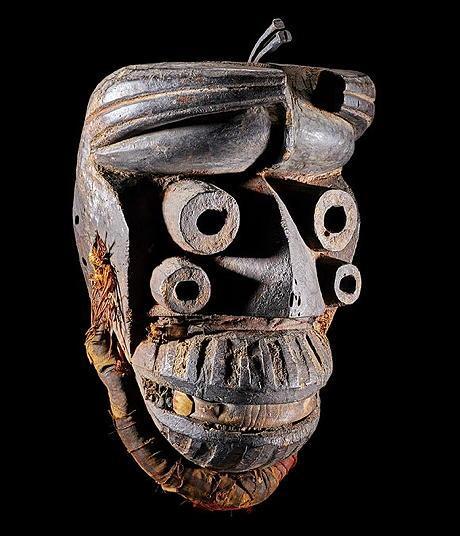
Mask, Liberia, coastal region Wobé. End 19th, beginning 20th centuries, wood, skin, steel, cotton, 33 cm. Photo © MEG, J. Watts.
IN THE AIR
Summer 2018, 10 exhibitions from Rodez to Hamburg
As we know, all there is to see is outdoors at this time of the year, whether in the streets, in the stadium, up in the mountains. It is the case for the World Cup, the Tour de France, concerts, the fireworks and even the demonstrations against Trump and his inanities. But museums have not disappeared, far from that. In the heat of the summer, and a very hot one no doubt, they offer a welcome alternative to the barbecues and lazy naps. It would be impossible to list all the enticing exhibitions, given their number. Here is a modest, road map that tries to link the “oldies but goodies” in Europe, the historical sites, the least known provinces and a handful of major capitals. And beyond, with furays to wider horizons: enjoy!
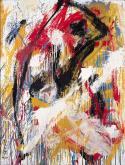
Saburo Murakami, Work, 1960, oil on canvas, plywood, 183,2 x 139,7 cm © Tomohiko Murakami, Courtesy of the Estate of Saburo Murakami and ARTCOURT Gallery Collection of Hyogo Prefectural Museum of Art (The Yamamura Collection).
Japanese fury
RODEZ – Happening, performances, Action Painting: we think they were all invented by American artists. Well, actually, the Japanese were the first to develop these artistic expressions. The audacity of a group of young artists in a country still under reconstruction, ten years after Hiroshima and Nagasaki, impressed Fluxus and Yves Klein. The members of the group Gutai, -which means approximately “concrete” - around their elder, Yoshihara, were true iconoclasts, making holes in canvases, rolling themselves into the pigments or painting with their feet while suspended from a rope. As part of the “Japonismes” season in France, some forty works are being shown at the Musée Soulages, on loan from the Hyogo museum in Kobe, including a lovely selection of Shiraga, who recently broke his record during an auction at Sotheby’s. One of the last members of the group, Matsutani, living in Paris, explained during the inauguration the energy of these artists who rebuilt on a clean slate.
• Gutai, l’espace et le temps at the musée Soulages, from 7 July to 4 November 2018.
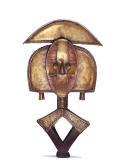
Bwete reliquary, Gabon, region of Haut-Ogooué. 19th century. Wood, copper, brass. H 57 cm. Gift Dr Georges Graz in 1929. MEG. Photo: © MEG, J. Watts
Ecstasy from Africa
GENEVA – Ecstasy and all cults or demonstrations of possession seem to belong more to football supporters during the World Cup than to the griots of the Sahel. Is football becoming a new religion? Most probably, but to establish this type of parallel and base it on a solid demonstration, nothing could beat plunging into the sacred and ecstatic dimension of traditional rites. The Musée d’Ethnographie does it by digging into its African collections. Divination, funerary rites, and sacrifices are referred to through masks, reliquary and Talismanic manuscripts: al tends to link the world of the living to that of the dead and the gods to ensure success and prosperity. No link has been proven with the round ball. Or not yet in any case.
• Religions de l’extase at the MEG, from 18 May 2018 to 6 January 2019.
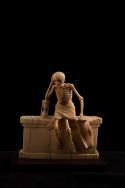
Skeleton in a shroud, sitting on a tomb, France, dated 1547 Ivory H. 9.6; L. 8.8; Depth 3 cm Donations baronne Henri de Rothschild, 1926 Musée des Arts décoratifs, Paris © Felipe Ribon
Looking at death right in the eye
TOULOUSE – Vanitas in the past was a recurrent theme among artists in the past: whether it was the trembling flame of a candle, soap suds, a timer, or even more, a skull, were used to remind man of the inanity of their projects, in face of the abyss after death. It took a certain doses of eccentricity to collect this type of representations, and even more so if the collector was a woman born at the end of the 19th century. But the baroness of Rothschild (1874-1926) had no such fears and had had daily contact with death as a nurse during the First World War. This surprising collection of skeletons and skulls (some of them smoking a cigar) has preserved its integrity through the donation the baroness made to the museum of decorative arts (Musée des Arts décoratifs). The Japanese ivories, the tiepins, and snuff oxes are accompanied by more recent creations by Alberola or Barceló, to show the permanence of the theme.
• Même pas peur! (Not even afraid) Les collections de la baronne Henri de Rothschild at the Fondation Bemberg, from 29 June to 30 September 2018.

Kota Ezawa, Flood, 2011, light box, 100 x 150 cm © Courtesy from the artist and galerie Anita Beckers, Frankfurt
The fury of Mother Nature
HAMBURG – Tsunamis in Asia, cyclones in the Caribbean, earth quakes in Mexico, Iran or in Haiti, downpours of rain over Japan, landslides in Honduras or in the Philippines: even though the number of deaths does not equal that resulting from wars, Nature delivers dramas of all sorts. These demonstrations of fury have always fascinated painters, photographers and writers, as can be seen in this retrospective that sometimes gives us goose bumps. The ocean is in the first row, with paintings by Vernet, Püttner or Isabey (his sinking of the Emily is breathtaking). Everyone can find his own pleasure here, with the variety of fires, volcano eruptions –no one can remain indifferent in face of the Vesuvius, such as Wright of Derby and Valenciennes. The exhibition shows interesting contemporary variations, in particular regarding floods, by Olphaert Den Otter or Kota Ezawa: the rise of the water levels has become the number one risk.
• Nature Unleashed. Images of the Catastrophe since 1600 at the Hamburger Kunsthalle, from 29 June to 14 October 2018.
Remember Beirut…
MARRAKECH – Cosmopolitan Etel Adnan (born in 1925 at Beirut) is seen as one of the great artists of the beginning of the 21st century, as can be seen in the increasing number of tributes to her synthetic and colorful landscapes in the museums and galleries, and a great poet. Bob Wilson (born in 1941 in Texas) is one of the world stage stars. Ceramic artist, and painter Simone Fattal (born in 1942 in Damas) is less known but is the indispensable third pillar of this original exhibition: she is Etel’s companion, as well as the editor of her work. The exhibition tells the story of this friendship, born in 1975 in Beirut, on the eve of the war of Lebanon, then its development in Morocco, in California, then Paris. A sort of choral choreography that mixes poetry, sounds and sculptures, to the rhythm of Etel Adnan’s poem – Conversation with my soul (III), interpreted by Robert Wilson on music by Michael Galasso.
• Garden of Memory at the musée Yves Saint Laurent, from 14 May to 16 September 2018.
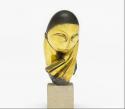
Constantin Brancusi, Mlle Pogany Version I, 1913 (after a marble of 1912). Bronze with black patina, 43.8 x 21.5 x 31.7 cm, on limestone base, 14.6 x 15.6 x 18.7 cm. Acquired through the Lillie P. Bliss Bequest (by exchange). © 2018 Artists Rights Society (ARS), New York/ADAGP, Paris.
Brancusi, an American story
NEW YORK – Exactly 105 years ago, in 1913, an unknown sculptor, a native of the depths of Rumania, created a sensation at the Armory Show, next to another great blaster of forms and shapes, Marcel Duchamp. The MoMA has a very rich fund of Brancusi sculptures (11), and it is exhibiting them for the first time, together with a series of documents, to show the impact this simplification of forms had at the time. Brancusi never set foot in the USA, but the MoMA has a boundless admiration for him: this is the 88th time his works are shown in a temporary show, which places him among the museum’s favorite, right behind the untouchables such as Picasso (314), Matisse (235) or Miró (197).
• Constantin Brancusi. Sculpture at the MoMA, from 22 July 2018 to 18 February 2019.
… and 4 paths to Picasso
In the boundless programs of the Parisian Andalusian artist, we can note his relationship to food, with a little help from chef Ferrán Adria (Picasso museum in Barcelona), his long friendship and rivalry with Matisse, centered around the question of the model (musée Matisse in Nice), the indispensable figure of the Minotaur in his production (palais Lumière in Evian) or even his travels, real or imaginary, symbolized by all the influences he stored and all the correspondence he received and kept (Vieille Charité in Marseille).

